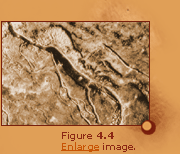|
|

Drainage Systems
 |
Channels could also form complex interconnected patterns as shown
in Figure 4.4. This area is near a volcano. The complex patterns
were probably created by the repeated major flooding caused by the
melting of ground ice during eruptions. Crater frequency in some
channel floors indicated that these channels were probably formed
3.5 to 4.5 billion years ago. At that time, the atmosphere might
have been more dense and the surface temperature might also have
been warmer. As a result, liquid water could have existed on the
Martian surface in that particular period of time. This is a simple
explanation for the formation of dendritic channels. However, the
validity of such an explanation has not yet been established. According
to this scenario, for example, rain was possible during the first
billion years of Martian history. Dendritic channels were formed
by surface runoff. It follows then that an ocean might have existed
during this time.
|
By the end of this period, Martian temperature and atmospheric pressure
dropped to a point where liquid water could no longer exist. Consequently,
formation of channels stopped and the ocean started to dry up. One problem
with this scenario is that it is not consistent with many observed channels
that do not possess a dendritic structure.
< back 1 2
3 4 next >
|



